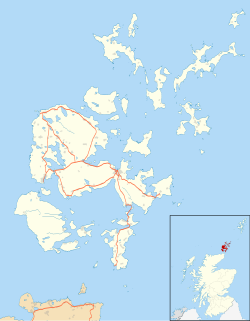Stromness Museum
 The museum's building on Alfred Street, Stromness | |
| Established | 1837 |
|---|---|
| Location | Stromness, Mainland, Orkney, Scotland |
| Coordinates | 58°57′28″N 3°18′04″W / 58.9577°N 3.3011°W |
| Owner | Orkney Natural History Society |
| Website | stromnessmuseum |
Stromness Museum is a small independent museum in the town of Stromness in Orkney, Scotland focusing on the town's connections to maritime and natural history. The building which accommodates the museum was originally constructed as the town hall of Stromness and is a Category B listed building.[1]
History[edit]
Following significant population growth, largely associated with the fishing industry, the area became a police burgh in 1856.[2] In this context, the burgh council decided to commission a town hall: the new building was designed in the neoclassical style, built in ashlar stone and was completed in 1858.[1][3]
The burgh council occupied the ground floor of the building while the Orkney Natural History Society, which had been founded in 1837, established a museum on the first floor of the building in 1858. In the 1920s, the burgh council relocated and the society acquired ownership of the building. The expanded museum was re-opened on the site by Lord Lieutenant of Orkney and Shetland, Alfred Baikie, in February 1931.[4]
The museum is now owned by Orkney Natural History Society Museum, a Scottish Charitable Incorporated Organisation, with members of the society electing a committee of volunteers to manage the museum.[5]
Collections[edit]
The museum's Orkney naval history collections include artifacts recovered from the scuttling of the German fleet at Scapa Flow and sunken Royal Navy ships, including a dumaresq from the Dreadnought battleship, HMS Vanguard.[6]
A number of items on display relate to arctic exploration, the 19th century Orcadian explorer John Rae, and indigenous peoples in Northern Canada. Artifacts include one of the only two Halkett boats known to still exist, and an Arctic medal awarded to the ill-fated Arctic explorer, John Franklin.[7]
Other exhibits include ethnographic items collected by Orcadians, William Balfour Baikie and Jack Renton, and items from James Cook's third voyage which landed in Stromness on its return home.[8]
The museum's natural history collection includes displays of taxidermied birds, fossils, and molluscs, including items collected by Charles Clouston and Robert Rendall, and the Homosteus milleri fossil discovered by Hugh Miller.[9]
In 2016, the museum discovered a 5,000 year old neolithic whalebone figurine in its Skara Brae collection that had long been considered lost.[10][11][12] In 2020, two Egyptian faience shabti from 1145 to 986 BC were identified in the museum's collection by researchers at the National Museum of Scotland.[13]
See also[edit]
References[edit]
- ^ a b Historic Environment Scotland. "50-56 (Even Numbers) Alfred Street, The Stromness Museum (LB45345)". Retrieved 28 September 2022.
- ^ "Stromness Burgh". Vision of Britain. Retrieved 28 September 2022.
- ^ Gifford, John (2003). Highland and Islands (Buildings of Scotland Series). Yale University Press. p. 66. ISBN 978-0300096255.
- ^ "A History of Stromness Museum | Stromness Museum". www.stromnessmuseum.org.uk. Archived from the original on 6 August 2021. Retrieved 5 August 2021.
- ^ "Orkney Natural History Society Museum, SC021455". Office of the Scottish Charity Regulator. Retrieved 28 September 2022.
- ^ "Unrecognised Vanguard relics found in Stromness Museum". BBC News. 15 October 2018. Archived from the original on 6 August 2021. Retrieved 5 August 2021.
- ^ "Sir John Franklin's Arctic medal found in Orkney museum". BBC News. 27 July 2017. Archived from the original on 6 August 2021. Retrieved 5 August 2021.
- ^ "Ethnography | Stromness Museum". www.stromnessmuseum.org.uk. Archived from the original on 6 August 2021. Retrieved 6 August 2021.
- ^ Denison, Robert (1978). Placodermi Volume 2 of Handbook of Paleoichthyology. Stuttgart New York: Gustav Fischer Verlag. p. 71. ISBN 978-0-89574-027-4.
- ^ "Ancient Skara Brae figurine rediscovered in 'last box'". BBC News. 14 June 2016. Archived from the original on 6 August 2021. Retrieved 5 August 2021.
- ^ Clarke, David; Anderson-Whymark, Hugo (1 June 2016). "A Re-discovered Figurine from Skara Brae, Orkney, Scotland". Past. 83. ISSN 0965-1381. Archived from the original on 6 August 2021. Retrieved 6 August 2021.
- ^ "Collections | Stromness Museum". www.stromnessmuseum.org.uk. Archived from the original on 6 August 2021. Retrieved 6 August 2021.
- ^ "Scotland's treasure trove of ancient Egyptian objects uncovered". www.scotsman.com. 16 May 2020. Archived from the original on 6 August 2021. Retrieved 5 August 2021.

